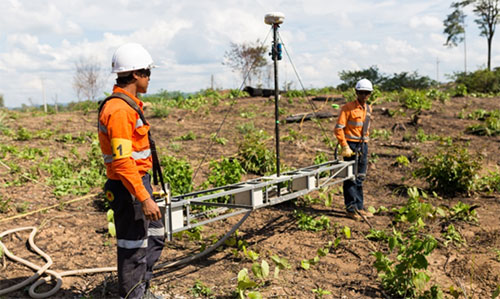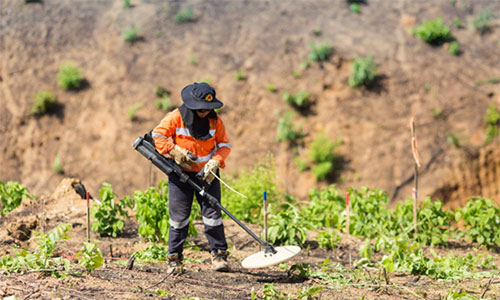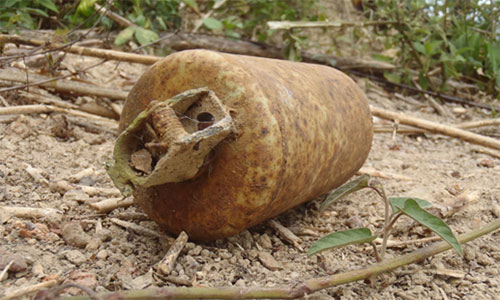The MMG Lane Xang Minerals (LXML) Limited Sepon mine is situated in a remote area of the Vilabouly district in Savannakhet province, which also happens to be one of the most bombed districts in the country.
Historically, Lao PDR (Laos) has been the most heavily bombed country, per capita, with over two million tonnes of explosive ordinance dropped on Laos between 1964 and 1973. It is estimated that up to 30% failed to detonate. Cluster sub-munitions or ‘bombies’ (as they are locally known) are the most commonly found undetonated UXO remaining in the local region. More than 270 million bombies were dropped in Laos. Of these, more than 80 million bombies remain undetonated, leaving a deadly legacy.
In the post war period between 1974 and 2018, over 21,000 people have been killed or injured as a result of UXO accidents, of which 25% of those injured were in Savannakhet Province. This risk has brought unique challenges to mining operations, development projects and agricultural production, in our local region.
LXML mines for progress by creating wealth for its people, host communities, and shareholders. To achieve this we must ensure our people and communities are safe. The company not only mines minerals, but also integrates UXO clearance as an essential activity in its mining cycle. In effect, contributing to improved living conditions of its communities by making them safer and by removing obstacles to development.
LXML mines and saves lives by investing in the software and hardware via strategic partnerships to enhance technical capacity and improve clearance practices for future generations in Laos.
UXO work in numbers
Around 80% of the 125,000 hectares of concessional land granted to LXML by the Lao Government, was heavily bombed during the Indochina War as part of the logistics route known as the ‘Ho Chi Minh Trail’. Since 1996, LXML has invested over US$45 million to help to address the problem of undetonated UXOs by working to clear approximately 2,900 hectares of land and destroying over 58,000 UXO items.
LXML is committed to implementing a procedure for UXO clearance activities in Sepon mine. These activities are carried out before our mining operations commence and to support projects and local village activities in local areas and archaeological sites. The method followed at Sepon mine, is as follows:
- UXO clearance before exploration – Local roads and tracks were cleared and enlarged during the exploration phase of the Sepon mine during the 1990s, allowing the local population safer and better access to rice fields and plantations.
- UXO clearance before civil engineering – The rehabilitation of a main transport route—Road 28A—linking Vilabouly with Road 9 (Savannakhet province’s main east-west highway), involved a full shallow and deep clearance of the entire stretch. Thousands of sub-munitions, aircraft bombs, aircraft rockets, and other ammunitions were cleared, allowing safer road access for the Vilabouly community.
- UXO clearance supporting development projects – LXML in partnership with Sunlabob supported safe and sustainable water supplies to villages in Vilabouly, using solar-powered pumps to draw water from unusually deep bore holes, which would not be accessible by using hand pumps. This project resulted in UXO clearance for the twelve targeted villages made up of almost 3,400 community members. The Mandarin Project, a partnership with Australian company Ironbark, created an opportunity for Lao farmers to move from subsistence to commercial agriculture by enabling smallholder families to grow mandarins using best practice technology. Before any plantations could commence, land areas were cleared from UXO. To date, beneficiaries of the project have planted mandarins covering nearly 22 hectares of land.
The software – enhancing capacity in the local region
LXML sponsored the 5th NRA Senior Explosive Ordnance Disposal (SEOD) to help build capacity for Lao Explosive Ordnance Disposal (EOD) technicians to attain the highest internationally recognised qualifications and experience in UXO clearance techniques. This course was the first of its kind run by the private sector, the Lao Army, and humanitarian operators.
In 2016, 35 LXML employees successfully completed the EOD Level 1 and 2 in-house training, increasing the number of qualified Lao personnel capable of supporting UXO operations. A further nine employees completed the ‘pathfinder’ training, an in-house training to those who at least complete and qualify for EOD level 1. The pathfinders are trained to accompany other people (like geologist, environment, and community relations employees) via the safest path to work areas that have not been cleared and potentially may encounter UXO.
The hardware – increasing speed and accuracy of UXO detection
LXML continues to investigate and invest in technologies to improve UXO identification and detection, particularly in the areas of advanced geophysical survey methods and mechanical clearance.
In 2015, LXML introduced new equipment to enhance UXO detection. The UltraTEM II Deep Bomb Detection System, developed by Australia’s Gap Explosive Ordnance Detection (Gap EOD), can detect UXO buried up to 3.5 meter underground.
The new system distinguishes closed space targets, provides accurate estimates of position and depths, and produces an auditable digital recording. The UltraTEM can detect an undetonated UXO in a single pass in all soil types, increasing speed and accuracy. This is particularly useful for the harsh mining environment at the Sepon mine.
LXML has a strong commitment to ongoing improvements and has fully supported these activities by participating in standardisation and field trials in Laos. Our company’s learnings, experiences and technologies are also shared with the wider UXO clearance community in Laos.
The assurance – maintaining the quality of UXO clearance
Throughout 2017, LXML reinforced quality management with the introduction of Free Form Explosive (FFE) UXO blind seed technology planted in land to be cleared. This technology ensures LXML’s UXO teams are consistently achieving and delivering high quality clearance and positively contributing to the safety of mining operations and the surrounding communities.
Each day, LXML’s UXO Quality Management coordinator plants at least one 1/2 FFE BLU 26 (single shell of cluster bomblet BLU 26) blind seed for up to twelve detectors.
Harnessing UXO knowledge – saving our people and communities
LXML is proud to have achieved zero-UXO related incidents within its clearance team. This reflects our commitment to consistently champion ‘Think Safety First’ to the unique hazards associated with UXO clearance.
In 2017, fifty LXML employees and contractors joined hands for an unexploded ordinance awareness day. The purpose was to raise awareness around UXO hazards and demonstrate how LXML’s highly skilled UXO clearance team make work areas and local communities safer.
Without UXO clearance, no mining activity could safely take place at Sepon mine. Employees are made aware of the risks and empowered to educate their local communities about the potential for UXO hazards and the assistance Sepon can provide in the local area.
LXML has also provided financial support to the Cooperative Orthotic and Prosthetic Enterprise (COPE) in Vientiane in an effort to provide support to those affected by undetonated UXOs in Laos and to also raise awareness of the support and assistance that LXML can provide.
LXML’s presence in Laos is removing obstacles to development and keeping people safe by enhancing capacity, investing in modern – state-of-the-art technology, and raising awareness on UXO through active partnership with key players in the UXO sector.
– End –

LXML UXO technicians use modern equipment – UltraTEM – to detect UXOs up to 3.5m deep at Sepon mine.

A female UXO technician, accounting for 8% of the workforce, of which 80% are local Vilabouly residents, uses a metal detector to locate UXO at Sepon.

BLU 17/B found in Sepon mine, contain white phosphorus that burns instantly when in contact with oxygen. It can create horrific injuries and its smoke is extremely harmful. (Photo credit: Yvon Le Chevanton)
Read the Media Release in Lao.